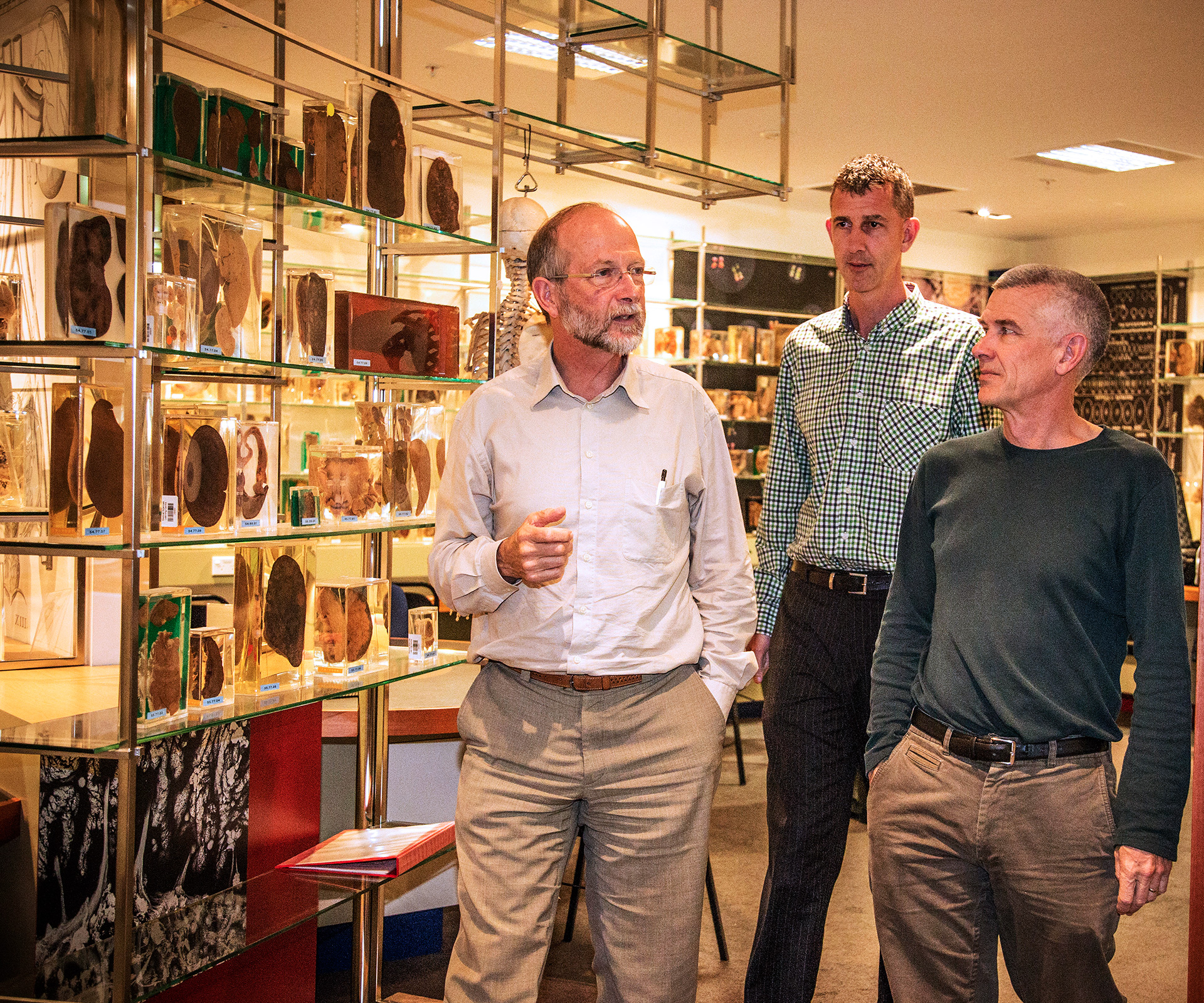Bones have been good to Ian Reid. People’s skeletal troubles – osteoporosis, for instance – have helped the University of Auckland distinguished professor win three prestigious science awards in one week. But Reid still thinks such recognition for his ground-breaking work is “a bit of an embarrassment”.
On November 10, the bone-disease expert received the Rutherford Medal at a Royal Society function in Auckland for “exceptional contribution to the advancement and promotion of knowledge in science and technology”, and the Health Research Council’s Liley Medal for research “that has made an outstanding contribution to the health and medical sciences”.
The third honour, presented the next day in Wellington, was the $500,000 Prime Minister’s Science Prize, awarded to Reid and associate professors Mark Bolland and Andrew Grey, all from the University of Auckland Medical School’s bone and joint research group.
The prizes recognise research by Reid and his team into the treatment and prevention of metabolic bone disorders such as osteoporosis. One of their key findings is that healthy people at risk of osteoporosis get no benefit from taking calcium or vitamin D supplements. This challenges traditional thinking – calcium supplements have been prescribed to prevent and treat osteoporosis since the 1980s – and has already saved billions of dollars internationally in reduced prescription costs.
When he was a boy, Reid decided he wanted to be a doctor, inspired by his mother, who was a nurse, and the family GP. After completing his training at the University of Auckland, he decided to do “a year of research so I could have better credentials”. In 1984, during a year working with Professor Kaye Ibbertson at Auckland Hospital, Reid became “completely hooked on research”.
“I think research and the practice of medicine complement one another wonderfully because if you’re practising in a reflective way, you’re constantly aware of what you don’t know. An awful lot of our research projects have come out of those sorts of clinical reflections.”
When Reid started working on osteoporosis, which is four times more common in women than in men, it was considered an inevitable part of growing old. “Bones were considered to be as biologically active as a piece of concrete”. A weakened skeleton, along with the occasional fracture, was thought to be a normal part of ageing.
But then researchers realised that bone “had cells in it that are making new bone and taking away old bone”. At around the same time, scientists developed ways of measuring bone density that helped to predict which patients were likely to have fractures. Treatments, including calcium and oestrogen, were found to increase bone density “so it became apparent that the skeleton was dynamic and able to be influenced”, says Reid.

Bone people: Ian Reid with Mark Bolland, middle, and Andrew Grey.
The other change is increased longevity. Today’s ageing population is more susceptible to osteoporosis, which has become a major public health problem.
“We’ve had enormous increases in the number of people having fractures and wanting strategies to prevent further fractures,” says Reid.
But if there’s no point in taking calcium or vitamin D supplements, what can healthy individuals do to prevent osteoporosis? Mostly, says Reid, it’s common-sense healthy living: don’t smoke, don’t drink alcohol to excess and maintain a healthy body weight.
And that doesn’t just mean staying trim. “Being skinny significantly increases your risk of having fractures. Older women of average height should ideally weigh more than 60kg. I think sometimes you can see the seeds of osteoporosis being sown much earlier in life when women are striving to keep their body weight well below that healthy level.”
When older people start to become frail, fall prevention becomes very important. Reid recommends people stay physically active and be careful in the way they interact with their environment. He suggests installing grab bars in bathrooms and tidying away items such as cords or mats that could be trip hazards, for example.
Reid also recommends that women in their sixties and men in their seventies have a bone-density check. If that suggests a vulnerability to fractures, “then there are a variety of medicines that are effective in preventing fractures and have a proven safety record”.
Another of his big contributions is the development of new osteoporosis treatments with bisphosphonate drugs.
“Some of these drugs can be given as infrequently as once every five years and still have significant beneficial effects on bone density.”
Reid’s work has also focused on Paget’s disease, which in the 1980s affected up to 10% of older Pakeha New Zealanders. The disease causes areas of the skeleton to become weak and deformed, sometimes leading to breaks. Depending on which bones are Pagetic, it can also lead to arthritis and neurological problems.
Reid and his collaborators found that bisphosphonate drugs also worked for Paget’s disease. “After 30 years of work, starting with quite weak bisphosphonate drugs and then more and more powerful ones, we have demonstrated that a single intravenous infusion of Zoledronate, a very powerful bisphosphonate drug, will cure the majority of people with Paget’s disease.”
However the incidence of the disease has coincidentally fallen by 80-90%, in what Reid describes as a “medical mystery”. He admits it’s “slightly frustrating” given that they now have a cure for the disease.
Looking at osteoporosis, Reid says better treatments are still needed, with present treatments reducing overall incidence of fractures by about 30%. He is also looking at the effectiveness of early intervention in osteoporosis.
“Eighty per cent of fractures occur in people with slightly reduced bone density, but who don’t actually meet the definition of osteoporosis.”
His team is running two long-term trials to see if they can prevent fractures in women with moderately reduced bone density, by treating them before they have their first fractures.
Although only the Prime Minister’s Science Prize is a team award, Reid sees all three awards as acknowledgement of the efforts of his whole group. His more than three decades of work on understanding and treating metabolic bone disease, brings together experts in laboratory work, patient care, radiology and statistics.
“The leader of a clinical research programme has oversight of all those things – but you can’t perform at a top international level unless you’ve got a whole raft of people who are making sure that their bit of the project is done absolutely to the best level possible.”
Words by Rebecca Priestley


